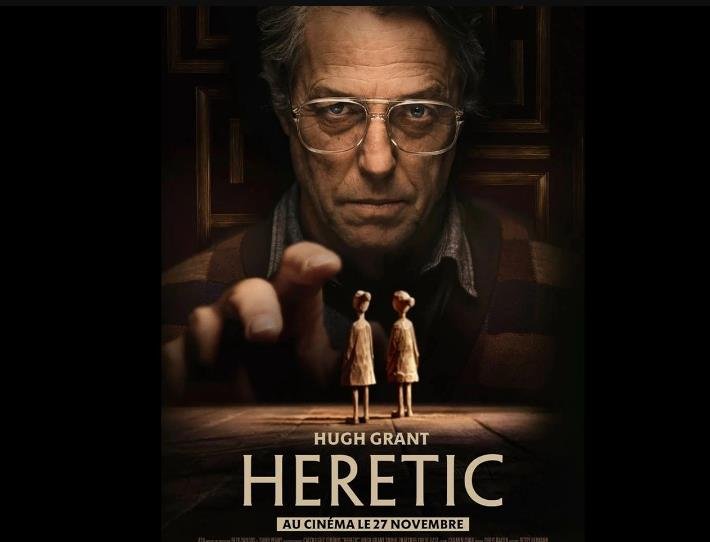In the latest thriller Heretic, audiences are drawn into a chilling narrative where psychological tension and cultural critique intertwine seamlessly.
Hugh Grant takes on a darker role in Heretic, portraying Mr. Reed, a seemingly devout seeker of the Church of Jesus Christ of Latter-day Saints (LDS). Unlike his charming on-screen personas, Reed’s character is manipulative and sinister, using religion as a facade to ensnare two young women. The film’s directors, Bryan Woods and Scott Beck, known for their work on A Quiet Place, craft a suspenseful atmosphere where every dialogue and interaction heightens the sense of impending doom.
Grant’s performance is a departure from his usual roles, bringing a palpable sense of menace to the screen. His portrayal of Reed is both convincing and terrifying, making the audience question his true intentions from the very beginning. This shift not only showcases Grant’s versatility but also sets the tone for a narrative that delves deep into themes of trust and deception.
Mansplaining as a New Dimension of Horror
One of Heretic‘s standout features is its innovative use of mansplaining as a horror element. For the first hour, the film builds tension through Reed’s relentless intellectual monologues about religion and faith. This method of storytelling taps into a common real-world experience, where women often find themselves subjected to unsolicited explanations and condescension.
The women protagonists, Sister Paxton and Sister Barnes, navigate these uncomfortable interactions with a mix of politeness and strategic disengagement. Their subtle glances and restrained smiles convey a silent struggle to maintain composure while seeking an escape from Reed’s oppressive rhetoric. This dynamic not only heightens the suspense but also serves as a commentary on societal expectations placed on women to remain courteous even in threatening situations.

Cultural Context: The Vulnerability of Mormon Missionaries
Heretic doesn’t just rely on psychological horror; it also explores the unique vulnerabilities of Mormon missionaries. The film highlights the cultural and religious pressures faced by young, dedicated individuals who serve missions, often in unfamiliar and isolated settings. Sister Paxton and Sister Barnes embody these pressures, their unwavering faith tested by the manipulative tactics of Mr. Reed.
The scene where teenage girls publicly humiliate Sister Paxton by pulling down her skirt and mocking her LDS temple garments underscores the societal challenges missionaries face even before encountering Reed. This moment serves as a catalyst for the ensuing horror, illustrating how external societal prejudices can compound personal vulnerabilities.
Building Tension Through Dialogue and Setting
The directors skillfully use the setting of a cold Colorado town and the confined space of Reed’s house to amplify the sense of claustrophobia and danger. As the missionaries arrive at Reed’s home, the initial act of sharing a blueberry pie—a seemingly benign gesture—quickly devolves into a nightmarish scenario. The contrast between the warmth of the pie and the ensuing terror creates a disorienting effect, keeping viewers on edge.
The lectures Reed delivers are meticulously crafted to increase the psychological pressure on the missionaries. Each conversation peels back layers of their composure, revealing their growing fear and desperation. This method of storytelling relies heavily on dialogue-driven suspense, allowing the audience to feel the protagonists’ mounting anxiety.
The Role of Gender Dynamics in Horror
Heretic also delves into the broader theme of gender dynamics within the horror genre. By positioning two women against a domineering male antagonist, the film taps into longstanding fears of vulnerability and powerlessness. However, it also empowers its female leads by showcasing their resilience and strategic thinking in the face of danger.
Sister Barnes, portrayed by Sophie Thatcher from Yellowjackets, brings depth to the role of a seasoned missionary grappling with her faith and safety. Her interactions with Reed reveal a complex character who must balance her religious convictions with the instinctual need for self-preservation. This nuanced portrayal adds layers to the horror, making the threat Reed poses not just physical but also psychological and emotional.
Audience Reception: A Mixed Bag of Praise and Critique
Since its release, Heretic has sparked diverse reactions among audiences and critics alike. Many praise the film for its fresh take on horror, particularly its focus on psychological tension and cultural commentary. Grant’s performance has been highlighted as a standout, bringing a new dimension to his acting repertoire.
However, some viewers have raised concerns about the portrayal of the LDS Church and whether it perpetuates stereotypes. The film walks a fine line between critiquing certain cultural practices and inadvertently reinforcing negative perceptions. This delicate balance has led to discussions about the responsibilities of filmmakers when addressing sensitive cultural and religious topics.
The Impact of ‘Heretic’ on the Thriller Genre
Heretic contributes significantly to the thriller genre by blending traditional horror elements with contemporary social issues. Its emphasis on psychological manipulation and cultural vulnerability offers a fresh perspective, challenging audiences to engage with the narrative on multiple levels.
The film’s success could pave the way for more thrillers that explore similar themes, using horror as a medium to comment on societal norms and personal vulnerabilities. By doing so, Heretic not only entertains but also provokes thought, encouraging viewers to reflect on the underlying issues presented.








